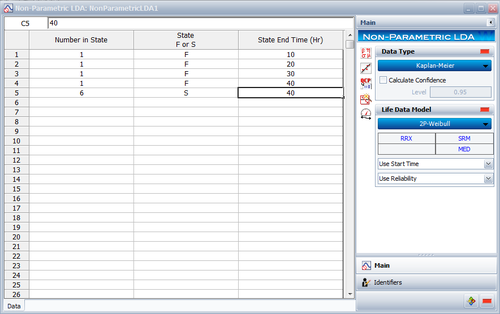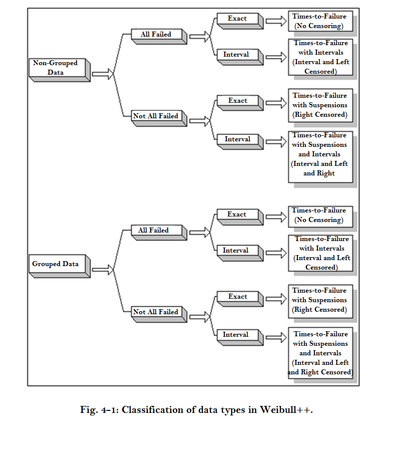Data Types in Weibull++
Data Types and Weibull++
Weibull++ allows you to use all of the above data types in a single data set. In other words, a data set can contain complete data, right censored data, interval censored data and left censored data. An overview of this is presented in this section.
Grouped Data and Weibull++
All of the previously mentioned data types can also be put into groups. This is simply a way of collecting units with identical failure or censoring times. If ten units were put on test with the first four units failing at 10, 20, 30 and 40 hours respectively, and then the test were terminated after the fourth failure, you can group the last six units as a group of six suspensions at 40 hours. Weibull++ allows you to enter all types of data as groups, as shown in the following figure.
Depending on the analysis method chosen, i.e. regression or maximum likelihood, Weibull++ treats grouped data differently. This was done by design to allow for more options and flexibility. Appendix B describes how Weibull++ treats grouped data.
Classifying Data in Weibull++
In Weibull++, data classifications are specified using data types. A single data set can contain any or all of the mentioned censoring schemes. Weibull++, through the use of the New Project Wizard and the New Data Sheet Wizard features, simplifies the choice of the appropriate data type for your data. Weibull++ uses the logic tree shown in Fig. 4-1 in deciding which is the appropriate data type for your data.
Analysis & Parameter Estimation Methods for Censored Data
In Chapter 3 we discussed parameter estimation methods for complete data. We will expand on that approach in this section by including estimation methods for the different types of censoring. The basic methods are still based on the same principles covered in Chapter 3, but modified to take into account the fact that some of the data points are censored. For example, assume that you were asked to find the mean (average) of 10, 20, a value that is between 25 and 40, a value that is greater than 30 and a value that is less than 50. In this case, the familiar method of determining the average is no longer applicable and special methods will need to be employed to handle the censored data in this data set.

